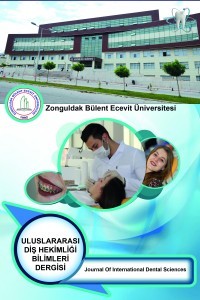Farklı Nikel-Titanyum Teller Tarafından Uygulanan Kuvvet Miktarının Ölçülmesi
Analyzing the Force Value That is Applied by Different Kind Of Nickel-Titanium Wires
Arch wires, NiTi, Orthodontics, Force,
___
- 1. Börekçi T. Sabit ortodontik tedavide kullanılan malzemelerin ortodontik tedavide etkinliği. Ege Üniversitesi Bitirme Tezi, İzmir 2012
- 2. Neelakantan L, Monchev B, Frotscher M, Eggeler G. The influence of secondary phase carbide particles on the passivity behaviour of NiTi shape memory alloys. Materials and Corrosion 2012; 63:979-984.
- 3. Abbasi-Chianeh V, Khalil-Allafi J, Kazemi-Choobi K. The effect of post-deformation aging on superelastic properties of NiTi thin wires attaining micro and nano-substructure. Journal of Alloys and Compounds 2013; 563:44-50.
- 4. Garrec P, Tavernier B, Jordan L. Evolution of flexural rigidity according to the cross-sectional dimension of a superelastic nickel titanium orthodontic wire. Eur J Orthod 2005; 27(4):402-407.
- 5. Tosun Y. Sabit Ortodontik Apareylerin Biyomekanik Prensipleri. Ege Üniversitesi Bitirme Tezi, İzmir 1999.
- 6. Liaw YC, Su YY, Lai YL, Lee SY. Stiffness and frictional resistance of a superelastic nickel-titanium orthodontic wire with low-stress hysteresis. Am J Orthod Dentofacial Orthop 2007; 131(5): 578.e12-8.
- 7. Khier SE, Brantley WA, Fournelle RA. Bending properties of superelastic and non superelastic nickeltitanium orthodontic wires. Am J Orthod Dentofacial Orthop 1991;99:310-312.
- 8. Andreasen GF, Hileman TB. An evaluation of cobalt substituted wire for orthodontics. J Am Dent Assoc 1971;82:1373-1375.
- 9. Brantley WA. Orthodontic wires. In: Brantley WA, Eliades T, editors. Orthodontic materials: Scientific and clinical aspects. Stuttgard, Thieme; 2001. 91-99.
- 10. Duerig TW, Melton KN, Stockel D, Wayman CM. Engineering Aspects of Shape Memory Alloys. Tiptree, Essex, UK: Butterworth-Heinemann; 1990. 3-20.
- 11. Santoro M, Nicolay OF, Cangialosi TJ. Pseudoelasticity and thermoelasticity of nickel-titanium alloys: A clinically orientedreview. Part I: Temperature transitional ranges. Am J Orthod Dentofacial Orthop 2001;119:587-593.
- 12. Lombardo L, Toni G, Stefanoni F, Mollica F, Guarneri MP, Siciliani G. The effect of temperature on the mechanical behavior of nickel-titanium orthodontic initial archwires. Angle Orthod 2013;83(2):298-305.
- 13. Fernandes DJ, Elias CN, Vidala R, de Moraes Mendes A. Mechanical performance of nickel-titanium archwires. Materials Research 2015;18(6):1264-1277
- 14. Meling TR, Odegaard J. The effect of short-term temperature changes on superelastic nickel-titanium archwires activated in orthodontic bending. Am J Orthod Dentofacial Orthop 2001;119(3):263-273.
- 15. Nakano H, Satoh K, Norris R, Jin T, Kamegai T, Ishikawa F, Kat sura H. Mechanical properties of several nickeltitanium alloy wires in three-point bending tests. Am J Orthod Dentofacial Orthop 1999; 115(4): 390-398.
- 16. Schemann-Miguel F, Cotrim-Ferreira F, Streva AM, Chaves AVOA. Comparative analysis of load/deflection ratios of conventional and heatactivated rectangular NiTi. Dental Press J Orthod 2012;17(3):23.e1-6.
- 17. Tonner RI, Waters NE. The characteristics of super-elastic Ni-Ti wires in three-point bending. Part I: The effect of temperature. Eur J Orthod 1994; 16(5): 409-419.
- 18. Lombardo L, Toni G, Stefanoni F, Mollica F, Guarneri MP, Siciliani G. The effect of temperature on the mechanical behavior of nickel-titanium orthodontic initial archwires. Angle Orthod 2013;83(2):298-305.
- ISSN: 2149-8628
- Yayın Aralığı: Yılda 3 Sayı
- Yayıncı: Zonguldak Bülent Ecevit Üniversitesi
İdiyopatik Osteosklerozun Nadir Görülen Komplikasyonu: Olgu Sunumu
Mehmet Özgür ÖZEMRE, Gediz GEDUK
Farklı Nikel-Titanyum Teller Tarafından Uygulanan Kuvvet Miktarının Ölçülmesi
Bilal AYAZ, Abdullah Bahadır AKÇA, Nurhat ÖZKALAYCI
Ortodontik Braketler; Bölüm II
Santral Dev Hücreli Reparatif Granüloma: Bir Olgu Sunumu
Murat ARSLAN, Turgay Peyami HOCAOĞLU, Fatmanur KETENCI
Post Yapıştırma Simanlarının Bağlanma Dayanımı ve Dentin Tübül Penetrasyonun Değerlendirilmesi
Yelda PALTUN, Sis DARENDELİLER YAMAN
Unilateral Kondiler Hiperplazi: KIBT Bulguları ile Olgu Sunumu
Mesude ÇITIR, Ayşe Zeynep ZENGİN
Sefa ÇOLAK, Ahmet ALTAN, Nihat AKBULUT
Alveolar Kemik Split Tekniğinde Otojen Kemik Grefti İyileşmesi: Histolojik Çalışma
